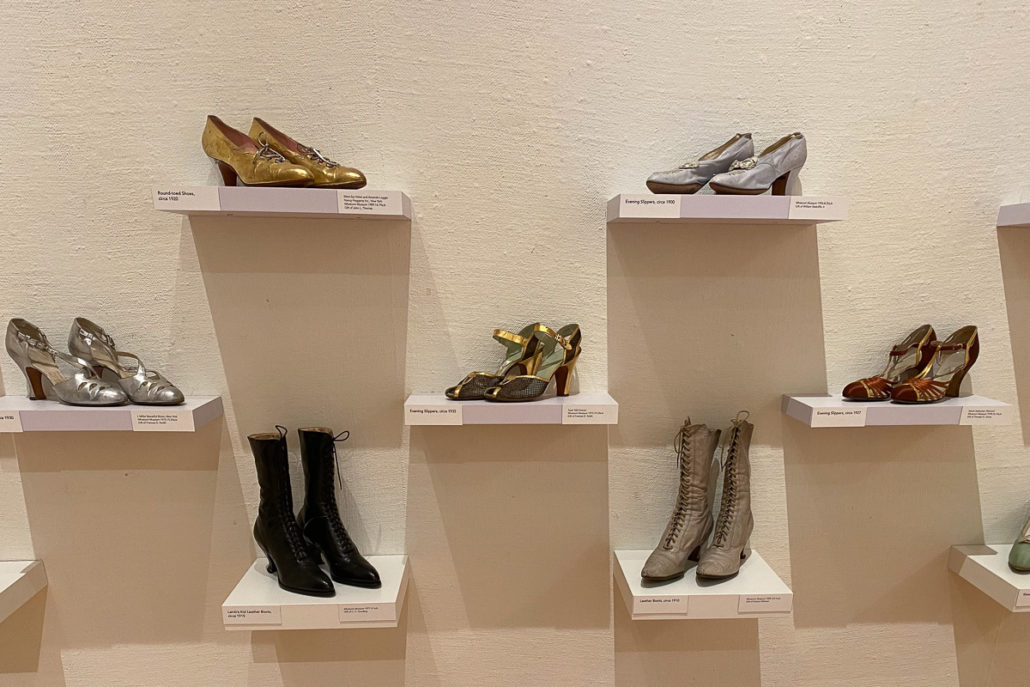Fantastic Fashion: Inside the Museum’s Clothing Collection
/0 Comments/in Uncategorized /by Christina ClaassenLacy evening dresses, leather pants, beaded shoes, and incredible hats adorned with feathers. These are just a fraction of the roughly 3,500 articles in our clothing collection. Explore examples of historic garments spanning from the 1800s through the mid-20th century in our exhibit All Dressed Up… at Old City Hall through Oct. 31, 2021.
Clothing Collection
The garments on view in All Dressed Up… stand out as exceptional in their design and exemplary of the aesthetics of their time. The exhibit allows us to examine fashion over the last century as a form of communication. Choices in attire can signal important information: the wearer’s status, affiliations, activities, or even their mood.
Curated by Maria Coltharp, the Museum’s Curator of Collections, the exhibit invites visitors to immerse themselves in the styles and color palettes of the past century.
From women’s dresses to hats and shoes, Coltharp offers insights into the various styles and materials on view. Below is a brief selection of the fantastic garments you can see in All Dressed Up… Visit us Thursdays-Sundays from noon-5pm before the exhibit closes Oct. 31!
Tea Dress, circa 1910
Silk and lace
Gift of Joyce Yorkston
The formality of the Edwardian era required changing dresses several times a day depending on one’s activity. A white tea dress was a wardrobe staple of middle- and upper-class women who would change into the airy dresses in the afternoon to socialize with one’s peers. Keeping the dress a crisp white was costly and impractical – an obvious signifier of wealth.

Sports Dress, 1936
Cotton with metal zipper
Gift of Clara Neilsen
This 1930s floor-length dress was worn as athletic wear, most likely to play tennis or golf. A short-sleeved bolero jacket would have completed the ensemble along with oxford-style shoes, or perhaps even a short heel. Pants were still widely considered menswear until World War II, so dresses were worn for practically all occasions.

Evening Dress, circa 1950
Taffeta, grosgrain ribbon, netting
Gift of Galen Biery
In 1947, designer Christian Dior unveiled his “New Look,” consisting of a prominent bustline, a cinched waist, and a full skirt. The hourglass silhouette was not exactly “new,” as Dior borrowed heavily from Victorian styles. What was new was the relinquishment of wartime rations and the return of some level of opulence to women’s dress. A full skirt can take up to 13 yards of fabric to create – an excess that was impossible during World War II.

Shift Dress, circa 1966
Synthetic materials
Gift of Frances D. Smith
This shift dress is a bright example of 1960s fashion. The influential style of Jackie Kennedy made the shift dress popular. Characterized by fabric falling straight down from the shoulders with darts around the bust, it is a simple construction that allowed total freedom of movement.

Leather Pants, circa 1973
Designer: Bonnie Cashin
Leather with synthetic lining
Gift of Virginia Weller
One of the most important designers in fashion history created this pair of electric blue leather pants. Modern fashion owes much to Bonnie Cashin and her quest to promote freedom of movement in women’s everyday clothing. Cashin was responsible for making leather and suede popular in the 1960s and 1970s and was the first to feature knee-high boots as part of her fashion ensembles.

Shoes
There are 267 pairs of shoes in the Museum’s collection, spanning from the 1820s through the 1980s. The shoes on display offer a brief survey of women’s shoe fashion, beginning with the Victorian Era.
Footwear in the Victorian Era (1837 – 1901) focused heavily on the daintiness of women’s feet, prompting many women to wear shoes that were several sizes too small for them, Coltharp writes. By the early 1970s, athletic shoe sales started surpassing that of high fashion shoe sales.
The small selection on display in All Dressed Up… begins with an extravagant pair of “dinner shoes” from 1910, featuring intricate beading and glass buttons. They belonged to the family of lauded Bellingham artist Helen Loggie.

Hats
There are 613 hats in the Museum’s collection, from 1800 through the late 1970s. The hats on display span from a Victorian feathered bonnet to an early 1960s pink geometric beret.
As with much of fashion history, certain hat styles went in and out of fashion through the years, Coltharp writes. Smaller hats were en vogue at the turn of the 20th century but became larger into the 1910s with more masculine styles and wider brims.
Several important hat designers are represented in All Dressed Up…, including Elsa Schiaparelli, Leslie James, Gene Doris, Lilly Daché, Sally Lynne, and Miriam Lewis. These women were not only creative geniuses but also business titans who shaped fashion trends for decades, Coltharp writes.

A note on diversity
All the items in our clothing collection have been donated, mostly by local enthusiasts. Coltharp writes that while the works are striking examples of changing design trends, there are many gaps in the story.
Most of the garments in the collection would have been worn by women with financial means, meaning that they were mostly wealthy white women, Coltharp writes. One reason for this disparity is that historically, clothing tended to be passed on through sale or gift, then used until completely worn out. The people who tended to keep special occasion clothing as mementos were women with means.
Another reason for the dominance of women’s clothing as opposed to men’s is the greater interest and attention given to women’s costume by historians.
Moving forward, we hope to acquire the items needed to create a more inclusive and socially relevant clothing collection. We feel strongly that designers from diverse backgrounds, clothing worn by BIPOC communities, more men’s fashion, and more non-gendered fashion should be included in this story.



